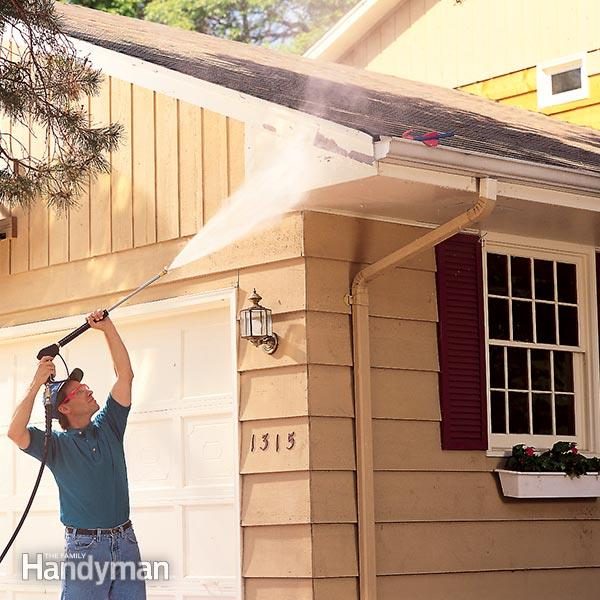Nothing cleans a house or gets it ready for painting faster than a pressure washer. Here's how to use this tool safely and effectively.
Introduction
A pressure washer cleans old paint fast. Here's how to pressure wash your whole house so that the new coat of exterior paint will stick better and last longer.
Tools Required
- Bucket
- Extension cord
- Paint scraper
- Rags
- Safety glasses
Project step-by-step (13)
A pressure washer is one of the best time-saving tools to come along in years. Its high-velocity water spray cleans dirt, grime and chalking paint from otherwise sound-painted surfaces. Pros like pressure washers not only because they’re fast, but because they scour the old paint so the new coat will adhere better. Using a pressure washer to remove paint definitely beats the old garden hose, scrub brush and TSP cleaning method, a task so slow that many people just skip it.
We’ll show you how to pressure wash your home effectively and safely without ruining the siding or compromising the future paint job. If you’re lucky and your paint is sound (no peeling), pressure washing may be the only prep work needed.
Check for chalking
Rub your hand over the painted surface and look for a powdery light-colored residue, the sure sign of chalking. Pressure-washing will scour it off to ensure a good bonding surface for the new coat.
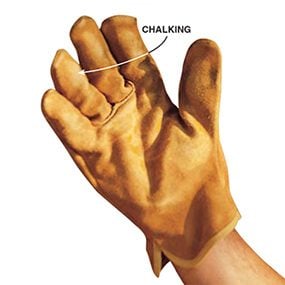
Repair before washing
Replace rotten boards and renail loose ones before pressure washing, so you don’t drive water through the siding and into the wall.
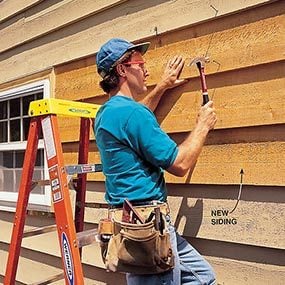
Rent a washer that produces at least 2,000 psi (pounds per square inch) of pressure. It’ll cost about $70 to $100 per day, and expect to keep it for a full day. You don’t have to be experienced to use one but be prepared for a day of physical labor. The washer will probably be gas-powered and weigh more than 75 lbs. Depending on its size, you might need a pickup or van to haul it and help to unload it. Ask the rental agent to show you how to hook it up and operate it, and to review safety precautions with you.
Pressure washers look like the ultimate squirt gun, but they aren’t toys. Don’t point them at anyone or try to rinse your hands or feet. They can tear your skin right off. If you don’t feel confident operating it, hire a pro.
Finally, make sure you get a 6 to 12-ft. extension wand to help reach high areas.
Hook up the pressure washer
Connect the pressure washer to the outdoor faucet through an ordinary garden hose, attach a nozzle (see “Selecting the Best Nozzle,” below) and start the engine. Wear goggles to keep paint chips and dirt out of your eyes, and clothing that can get soaked. You WILL get wet. Spread old sheets or painter’s cloths on the ground and over shrubbery to catch paint chips.
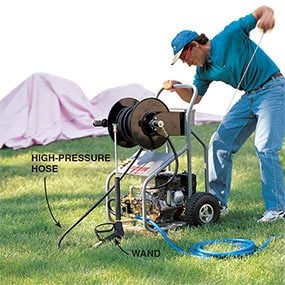
Selecting the Best Nozzle
Pressure washers usually have three or four nozzles with spray patterns of varying widths. Attach the 15 or 25-degree nozzle to the wand for general paint cleaning, then test the effect on the siding. The spray should clean away all dirt and chalk without damaging the siding. Rub the surface with a clean glove to make sure the chalk comes off.
If it doesn’t, try a nozzle with a narrower pattern. Don’t use the narrow, zero-degree nozzle. It’s powerful and can quickly damage wood, stucco and other materials. Also, make sure the nozzle coupling locks into place securely so you don’t blow the nozzle through a neighbor’s window!
Pressure washing nozzles
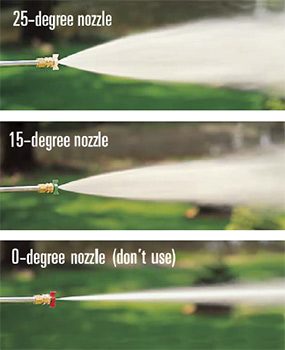
Practice first
Practice handling the washer in a low area first. Hold the wand with two hands and move it across the siding from side to side at a steady pace. Start about 2-ft. from the siding, then move closer until you find the optimal cleaning distance. In general, work at a horizontal or slightly downward angle to avoid driving water up under the siding.
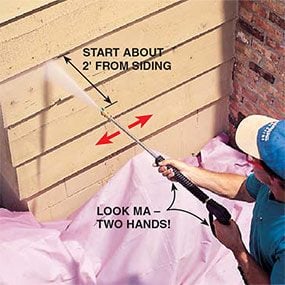
Work from the top down
Begin washing the walls at the top and work down. Wash the gutters and soffits as well as the siding. Direct the spray away from breakable objects like windows and outside lights, and remove house numbers and window boxes whenever possible.
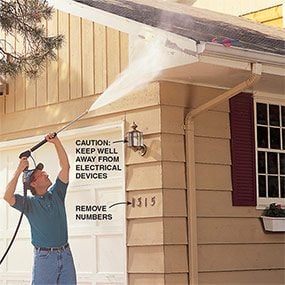
Scrape after washing
Pressure washers will remove loose paint, but they’re not a substitute for scraping. We’ll have to scrape additional loose paint after pressure washing this area anyway.
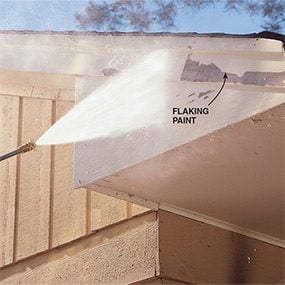
Don’t hold the nozzle too close
If you hold the nozzle too close or for too long in one spot, you’ll gouge the wood. We’ll have to fill this area with wood putty before repainting. Gouging is inevitable if you try to strip paint.
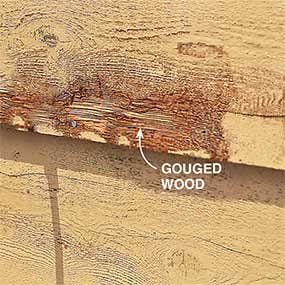
Point away from windows
Direct the nozzle away from windows, holding the wand at an angle so you don’t drive water into joints, gaps or against the glass. Even so, check the sill on the inside and dry up any water that leaked through. Remove the shutters after washing and wash them underneath.
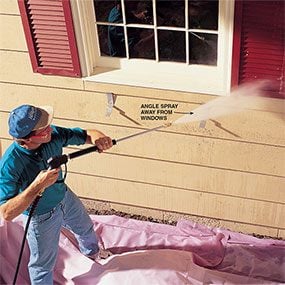
Use an extension wand
Use an adjustable extension wand (6 to 12-ft.) to wash high areas. At full length, the wand takes some muscle to handle. Good control takes some practice, but it’s safer than pressure washing from a ladder. Remember to close all the windows!
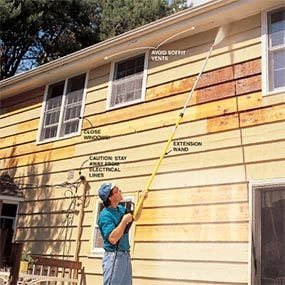
Scrub inaccessible areas
Clean high areas beyond the reach of the pressure washer extension with a scrub brush and a solution of detergent and TSP mixed in water. Begin from the lower areas and work upward, rinsing frequently. Keep the siding below damp so the TSP won’t leave visible drip marks. When finished, rinse from the top down using a garden hose. An add-on ladder stabilizer makes the ladder more secure.
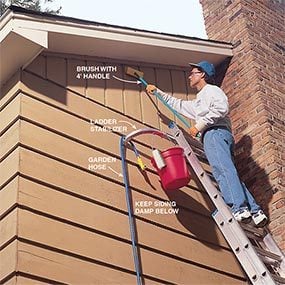
If you haven’t handled a pressure washer before, be sure to take a few minutes to practice, get a feel for the wand, and choose the most effective spray pattern. For better control and to keep your arms from tiring, use two hands.
Other pressure washing tips:
- While it’s best to wash with the wand aimed downward, at times you’ll have to point it somewhat upward, especially under soffits. When you do, remember the general rule not to drive the water directly into cracks or gaps. And always avoid shooting water up into soffit vents.
- We don’t recommend that you pressure-wash while standing on a ladder; the recoil from the pressure can knock you off balance.
- Steer clear of electrical devices like lights and outlets. You can easily cause a short circuit or break them.
Warning: Keep the wand and water stream at least 6-ft. away from electrical wires. A shock from your service wires can kill you.
- Stripping loose paint and gouging the wood in the process is the most common rookie mistake and will leave you with time-consuming, difficult wood repairs.
- Give your house at least a week of good drying weather before applying paint.


















